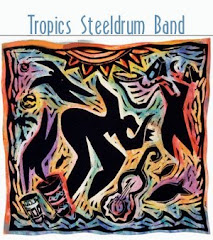 "I remember when we used to sit/ In the government yard in Trenchtown.../ And then Georgie would make the fire lights/ And it was logwood burnin' through the nights/ Then we would cook cornmeal porridge/ Of which I'll share with you..."
"I remember when we used to sit/ In the government yard in Trenchtown.../ And then Georgie would make the fire lights/ And it was logwood burnin' through the nights/ Then we would cook cornmeal porridge/ Of which I'll share with you..."These days, people in Trenchtown, a gritty, violence-wracked district of Kingston, don't gather around logwood fires, sup on communal broth and sing songs any longer.
Life has moved on in Bob Marley country.
But 26 years after the death of the reggae superstar, Trenchtown, which gave birth to reggae music and its legend, is trying to showcase its most prominent resident's legacy.
It is all happening in the "government yard", the public housing project where Marley lived and which he sang about famously in his songs.
This was also where he wrote his first songs, learnt to play the guitar, met fellow musicians like Peter Tosh and went on to form the Wailers, reggae's most famous band. He also travelled to a studio from the ghetto to record their first album, Catch A Fire.
This yard - a warren of 16 cramped rooms where Marley and his friends lived - are being restored by Jamaican architect Christopher Whyms-Stone with help from donations from the British, German, Canadian and American embassies.
Marley memorabilia have been put up in the rooms, the interiors have given up a fresh lick of paint and the legend's first guitar is also on display.
In the singer's impossibly small home with a concrete kitchen counter and a small bed, there is a fraying poster of the Wailers.
Even his beat-up 1970 Volkswagen, which was rescued from the detritus with graffiti reading "Live and let others live" intact on its windows, may be repaired and retro-fitted by the German automobile maker.
"Marley and his fellow residents hardly lived in their one-room homes. They would only sleep in the room at night. The rest of the time they would spend time outside with neighbours. They lived in the verandas, courtyards and streets and mingled with the people," said Mr Whyms-Stone.
Social engineering
It is not easy to attract visitors to the "culture yard", as the Marley home is now called.
Trenchtown's image as a violent neighbourhood in crime-ridden Kingston scares away most tourists, who would otherwise like to make the place their main stop on the Bob Marley memory lane trip.
"The problem is wooing the local tour operators to come to the area. The way to counter [the image] is through reducing crime and by massive advertising," says Mr Whyms-Stone.
Marley lived in one of Jamaica's most ambitious social engineering exercises - a cluster of homes with cedar doors and windows and gable roofs built around courtyards with communal bathrooms - all to encourage a thriving, but orderly community life.
 Residents of the yard, set up in the early 1940s, had to abide by stern laws. You could not display or keep poultry in a cage, cut down fruit trees or let bathwater run into the area.
Residents of the yard, set up in the early 1940s, had to abide by stern laws. You could not display or keep poultry in a cage, cut down fruit trees or let bathwater run into the area.The community thrived in the yards and spawned great talent. Reggae pioneer Joe Higgs, West Indian cricketer Collie Smith, Rastafarian elder Mortimer Planno, black nationalist William Grant and a host of cracking musicians, including Peter Tosh and Bunny Wailer, lived and worked here.
Old-timers here still fondly remember Marley, who died of cancer in 1981, as a man who put a run-down Jamaican neighbourhood on the world map.
They tell stories of how he played football when he was not singing, how he drove around with fellow Rastafarians in his Volkswagen, how he would return to the ghetto with bagfuls of money to distribute after he found money and fame.
Spiritual legacy
The most popular of all stories involves Vincent Ford aka Tarta, the legend's childhood friend who ran a soup kitchen in Trenchtown.
People in Trenchtown believe that Tarta not only taught Bob how to play the guitar but also wrote the words to No Woman No Cry, about their time in the yard.
Others, including many critics, say Marley credited Tarta with the words, so that his friend, disabled and ravaged by diabetes, could fend for himself all his life.
Trenchtown old-timer and Marley pal Cutty, who runs a stew and fish house, remembers the time when the singer would play football in the evening every evening.
"If he hadn't become a singer, he would have definitely become a great footballer," he says.
 Across town, every year some 2,500 people visit Marley's posh-looking colonial bungalow, with latticed windows and marble stairway, which has been turned into a museum. They also buy T-shirts at the souvenir shop and snack on Ethiopian food.
Across town, every year some 2,500 people visit Marley's posh-looking colonial bungalow, with latticed windows and marble stairway, which has been turned into a museum. They also buy T-shirts at the souvenir shop and snack on Ethiopian food.Here, Marley rehearsed five albums and even survived an assassination attempt. His musician children continue to record at the in-house studio.
But Trenchtown remains the place where Marley's spiritual legacy is truly alive and well. The yard, set in bleak surroundings, receives at least 50 tourists a month without any advertising.
As old-timers say, the ghetto gave Marley the real vibe. As he sings in Trenchtown Rock: "One good thing about music, when it hits, you feel no pain... /Hit me with music now, oh now, hit me with music now."
--BBC Caribbean.com



No comments:
Post a Comment